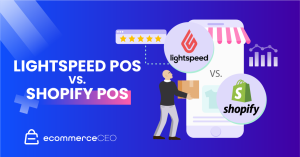As the digital shelf continues to bring in more direct sales, it’s not uncommon for you to receive concerns, pushback, or confusion from your traditional internal salesforce or leadership team — especially if there’s a strong push for change through digital transformation.
These conditions may lead to discussions about channel conflict and cannibalization. Your salesforce is likely protective of brick-and-mortar stores and relationships, and wary that their territory will suffer if too much of their business occurs digitally, instead.
However, as ecommerce grows, the opposite is actually true. In order to be successful in today’s evolving marketplace, you need a strong omnichannel strategy that empowers your brand to reach consumers in a powerful, consistent way across channels — ultimately driving conversions both online and in-store.
Everyone Is Moving Toward Ecommerce
It’s not just consumers who are driving digital transformation. Business buyers also want the option to browse and purchase online.
For example, as highlighted by Industrial Distribution, Amazon Business, a business marketplace launched in 2015, reached $25 billion in worldwide annual sales in 2021.
If you’re considering expanding to Amazon Business or other digital portals, you may need to help your brand overcome a fear of channel conflict and cannibalization.
In reality, offline sales will suffer without a strong digital footprint. According to a study by the Digital Shelf Institute (DSI), for every dollar consumers spend online as a result of retail advertising campaigns, another $7 to $11 is spent offline in stores.
Here are three common channel conflict and cannibalization myths, debunked:
Myth 1: Ecommerce Sites Will Cannibalize Profits From Your Offline Channels
It’s common for brands to shy away from ecommerce when they perceive it conflicts with their other, long-established channels. After all, digital channels require you to take more direct ownership over your pricing, logistics, and merchandising strategies.
However, participating in ecommerce isn’t optional anymore.
Building out your digital presence boosts discoverability and consumer confidence in your product catalog — ultimately empowering you to drive sales across channels.
The Truth: There’s Enormous Risk in Not Going Digital
Salsify’s “Consumer Research 2022” report breaks down survey data from more than 4,000 shoppers across four markets.
When asked where they were most likely to research and compare products before buying, only 17% of French shoppers, 14% of German shoppers, 10% of U.S. shoppers, and 8% of British shoppers said they would do so in-store.
The remaining respondents claimed to primarily conduct this type of research on a retail site, on a retail app, through a search engine, on social media, on a brand’s own site, or via voice technology.
However, when asked where they would be most likely to ultimately make a purchase, 40% of U.S. consumers, 38% of French consumers, 30% of German consumers, and 25% of British consumers claimed they would do so in-store — emphasizing the impact of a strong digital presence on brick-and-mortar sales.
Myth 2: A Multichannel Sales Strategy Will Weaken Your Brand Story
It may feel like selling on Amazon and other third-party retailer sites opens your brand up to the risk of dilution. In reality, providing other sites with your product information doesn’t make it more confusing for customers, but easier.
According to Salsify’s “Consumer Research 2022” report, 42% of U.S. shoppers, 38% of British shoppers, 33% of French shoppers, and 31% of German shoppers are most likely to research and compare products on a retail site before buying.
Providing a detailed, comprehensive, and accurate listing on every site you can will only expand your digital footprint — allowing you to increase your share of search and sales.
The Truth: It’s All About Your Customer’s Experience
It’s not about your brand story; it’s about your customer’s experience. The very purpose of a multichannel or omnichannel sales strategy is to capitalize on the increased product visibility and consumer access provided by each unique outlet. This type of strategy can be an important tool for meeting the growing consumer demand for information — no matter where they shop.
Myth 3: There’s No Accurate Way to Measure How a Salesforce or Distributor Contributed to Online Revenue
Your team may worry that a website is going to get a disproportionate amount of credit for sales that were influenced by offline sources. Some brands are flipping this fear on its head and giving credit offline when online sales are made.
One model to consider here is to use the geographic territories you’ve already established and apply them to online sales, as well. For example, if a buyer purchases from Amazon Business, credit the salesperson or distributor in the buyer’s geography with the sale.
This evens the playing field and removes any friction that a local offline retailer might have had in directing buyers online for more information about a product or delivery.
The Truth: Acting Holistically Is Critical to Your Success
A hyper-focus on channel-specific return on investment (ROI) creates problems for businesses in the long run. Build the experience a consumer wants, and align your entire organization around the shopper’s needs rather than an old-world compensation model.
Operating successfully in a digital world requires the adoption of product experience management (ProductXM) across the entire organization.
Start by creating and centralizing the most accurate, compelling information about your product — and then adapt continuously as you grow.
Activate and syndicate this product content to meet the requirements of each individual channel. This empowers you to reach your customers wherever they are — retailer sites, direct-to-consumer (DTC) sites, search engines, social media sites, review sites, and other channels.
Finally, align your operations in such a way that you can quickly iterate on the process, ensuring your content is always optimized based on the latest consumer behaviors, channel feedback, and market forces.
Online and Offline Must Be In-Sync for Success
Consumers’ online experiences impact their in-store purchases tremendously. You can’t have an effective brick-and-mortar strategy without a click counterpart.
Debunk channel conflict and cannibalization myths by sharing these digital-age realities with your salesforce — and adjusting internal incentives accordingly. Doing so will help your teams align to meet customer demand, deliver winning product experiences, adapt to market changes, and stay ahead of the competition.
For additional support navigating digital transformation or overcoming related conflicts, check out “The Change Management Guide for Digital Transformation in Commerce.”




